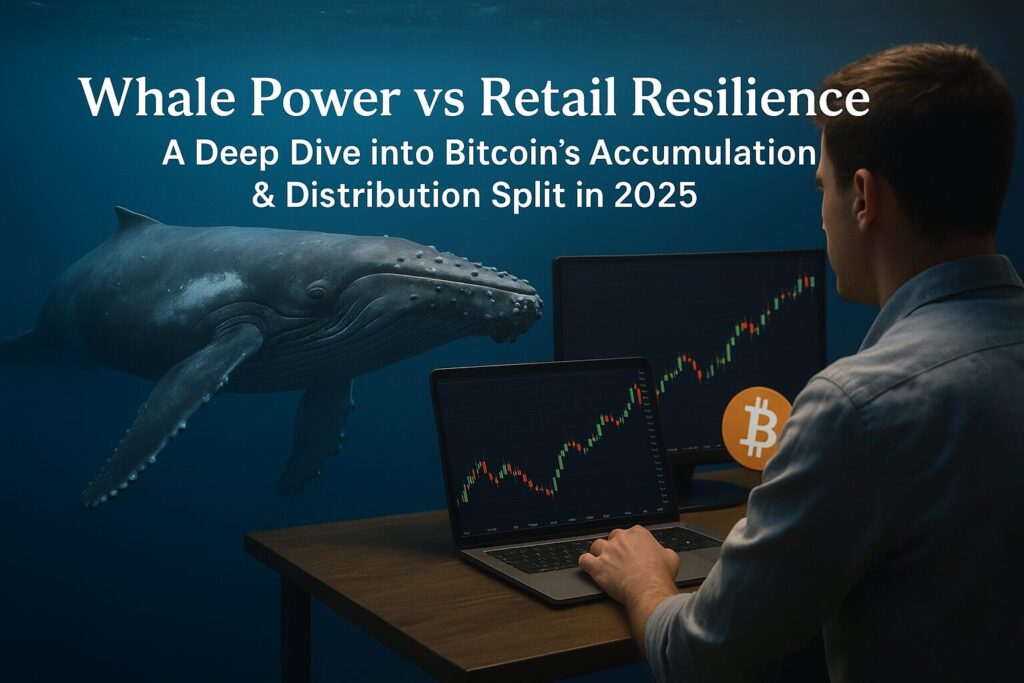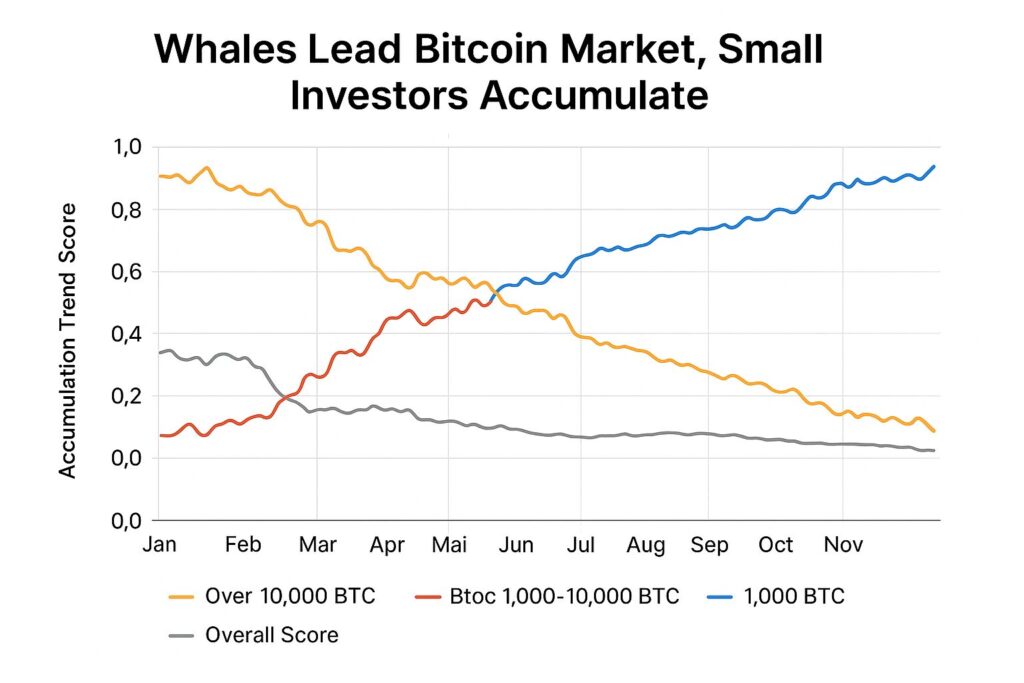
Main Points :
- Large-scale holders (so-called “whales”) of more than 10,000 Bitcoin (BTC) have shifted behaviour, alternating between strong accumulation and subsequent distribution phases.
- Smaller investors — those holding under 1,000 BTC — have shown more persistent accumulation, diverging from whales at key moments.
- The on-chain metric Glassnode’s Accumulation Trend Score (ATS) reveals a clear segmentation of investor behaviour by wallet size, underscoring a structural divide in the market.
- These behavioural dynamics are playing out against a backdrop of macro-tailwinds (spot BTC-ETFs, regulatory clarity, institutional flows) and technical price structures, which may signal a forthcoming strategic shift.
- For readers seeking new crypto assets, income opportunities, or practical blockchain use cases, understanding how whale behaviour influences supply, liquidity and issuance is crucial.
1. Whale Domination in the Bitcoin Market
Large-scale holders (addresses with 10,000 BTC or more) have long been tracked as key market participants in the Bitcoin ecosystem. According to Glassnode’s ATS metric, such whales achieved high accumulation scores (near 1.0) in certain pockets of 2025, indicating intense buying momentum.
In April 2025, for example, wallets holding 10 k+ BTC recorded an ATS reading around 0.90.
Yet, despite this, the market experienced significant price weakness — among the chief explanations is that such large holders also timed distribution phases, thereby exerting downward pressure. For example, in May the same 10 k+ cohort shifted into distribution as part of consolidation.
What this means: the whales continue to have outsized influence on supply flows and thus have the potential to drive or dampen momentum.
2. Divergence Between Whales and Retail/Small Investors
Meanwhile, smaller wallet cohorts—particularly those holding under 1,000 BTC (and especially under 1 BTC) — have demonstrated a contrasting pattern. According to data referenced in recent reports, wallets with less than 1 BTC have been steadily in “buying” mode, while mid-tier cohorts (1,000–10,000 BTC) often hovered around neutral.
For example, one report noted:
What this divergence suggests: retail and smaller investors may be more steadily accumulating, perhaps dollar-cost averaging or believing in long-term thesis, whereas whales are more opportunistic—accumulating when they sense weakness, distributing when they sense strength.
3. The Accumulation Trend Score (ATS) as a Behavioral Indicator
The ATS — computed by Glassnode — takes into account both 15-day net acquisition (or distribution) behaviour and the size of wallets. A reading close to 1 indicates strong accumulation, near 0 indicates distribution.
Breaking it down by cohorts provides richer insight. For instance:
- 10,000 BTC cohort: peaked near 0.9 in certain periods.
- 1,000–10,000 BTC cohort: somewhere around 0.7 to neutral (≈ 0.5) depending on period.
- < 1 BTC cohort: historically lower, but has shown improved accumulation in recent months.
Graphically, one can observe shades of red/dark for strong accumulation across cohorts in recent months.
From the practical viewpoint of a market participant looking for new assets or income: monitoring the ATS across cohorts gives a signal of how conviction is aligning across the supply chain — large whales, midsize holders, small holders — which can lead or lag price. A rising ATS across cohorts suggests broader conviction, which may set the stage for an asset breakout.

4. Market Implications: Supply, Liquidity and Asset Entry Strategy
Supply & Liquidity Dynamics
When whales begin to sell (distribution), they can increase supply into exchanges or OTC venues, create liquidity, and potentially cap upward price movement. Conversely, when they accumulate, they may withdraw coins from circulation, reducing available supply and setting the stage for scarcity-driven price moves. For example, a report noted whales were absorbing more than 300 % of new issuance.
For smaller investors, sustained accumulation suggests building conviction or belief in long-term thesis rather than short-term speculation.
Asset Entry & Income Opportunity Implications
For someone scouting new crypto assets or designing income streams or blockchain use cases, this behavioural divide offers practical cues:
- If whale accumulation becomes broad-based (large + mid + small holders): that signals a phase of increasing conviction across the ecosystem, which might be a good entry time for core assets (e.g., BTC, ETH) and derivatively for adjacent infrastructure or “next-wave” assets.
- If whales begin distribution while smaller holders accumulate: this may indicate a phase of consolidation, increased volatility, or preparation for a corrective move — caution is warranted.
- Inclusion of newer blockchain use cases (staking incomes, DeFi protocols, real-world asset tokenisation) might benefit when large holders show accumulation: it implies capital is moving into the space, not merely speculative flows.
For example, if you are exploring a new token or ecosystem, correlating its token-holder cohorts’ behaviour (via on-chain analytics) with the major network’s (e.g., Bitcoin’s) cohorts may give you indication whether you are in a tail-wind or head-wind environment.
5. Macro & Technical Tailwinds Amplifying the Narrative
The current environment for crypto is being supported by a confluence of macro and technical factors. One recent analysis noted:
“All Bitcoin wallet cohorts — including >10k BTC whales — are back in high-conviction accumulation mode” and that the BTC/USD price was aiming toward ~$124,000.
Key macro tailwinds:
- Institutional flows via spot Bitcoin ETFs – raising participation beyond retail/whale dichotomy.
- Regulatory progress in the U.S. around stablecoins and crypto frameworks – improving confidence for large capital.
- Expectations of interest-rate cuts or looser monetary policy – weakening the dollar, improving the appeal of crypto as an alternative store of value.
In technical analysis: symmetrical triangle breakout patterns, RSI metrics not yet overbought, etc., suggesting further upside is possible.
For you as a developer or crypto investor: these tailwinds matter when evaluating project timing, income-model feasibility (e.g., yield in DeFi), or tokenomics of new assets. If the macro supports accumulation and supply withdrawal by whales, new assets may benefit indirectly via spill-over capital.
6. What This Means for Blockchain Use Cases, Income Streams and Altcoin Discovery
Blockchain Use Cases & Practical Implementation
The divide between whales and smaller investors reveals something about network infrastructure: when large holders accumulate, they aren’t just chasing price — they are implicitly endorsing long-term value and custody frameworks. That matters if you are developing or evaluating non-custodial wallets (e.g., your project “dzilla Wallet”), or DeFi protocols: institutional grade custody, transparency and UX matter.
Income Streams & Yield Strategies
In an environment where large holders are accumulating and likely holding long-term, yield strategies (staking, liquidity provision, tokenised real-world assets) can be more durable. New assets that offer transparent yield, audited contracts and robust token-omics may benefit from a long-term capital base rather than short-term flipping.
Altcoin Discovery
For readers seeking “the next asset”: while BTC behaviour doesn’t guarantee an alt-coin’s success, it provides a market backdrop. When whales accumulate BTC, capital may rotate into adjacent assets once price momentum picks up. Conversely, if whales are distributing, risk for alt-coins becomes higher because supply may not be withdrawn and capital may flee. Thus, tracking Bitcoin cohorts is a “canary in the coal mine” for alt-asset sentiment.
Therefore: you may want to monitor on-chain analytics for the crypto ecosystem you are investigating (wallet-cohort behaviour, accumulation vs distribution, supply on exchanges) and align your asset-discovery process accordingly.
7. Recent Trend Summary & Time-Sensitive Signals
- As of mid-2025, data shows that wallet cohorts holding >10,000 BTC moved from accumulation back into distribution in some periods (e.g., May).
- More recently (July), multiple sources suggest that all cohorts (whales, midsize, small) have aligned into accumulation mode, indicating a broadened conviction that could precede a breakout.
- For investors or project-builders, the key signals to watch: ATS approaching or exceeding ~0.8 across large and midsize cohorts; supply on exchanges decreasing; large entities withdrawing coins; new issuance being absorbed by large holders (e.g., absorbing >100 % of new supply).
- Conversely, a warning signal would be: accumulation score falling, large holders distributing, supply flowing to exchanges, wallets under 1 BTC selling – all of which may hint at a top or consolidation phase.
Conclusion
In summary, the market behaviour of Bitcoin’s large holders (whales) versus smaller investors is more than just an academic curiosity. It points toward underlying structural dynamics in supply, liquidity and conviction that impact not only Bitcoin’s trajectory, but the broader crypto ecosystem — including alt-assets, yield strategies, and blockchain infrastructure.
For you, the takeaway is two-fold:
- As an investor/asset-scout: Track on-chain metrics like the Accumulation Trend Score across wallet cohorts to gauge when capital is truly aligning behind an asset. Broad-based accumulation often precedes strong moves.
- As a builder/developer: Recognise that institutional/whale capital isn’t simply speculative – long-term accumulation signals varied requirements: custody, UX, security, regulatory clarity, yield viability and ecosystem robustness. Your product or protocol should align with the capital base seeking durability, not just quick flips.
In the current 2025 environment, we appear to be at a pivotal moment: either the market is coalescing into a broad accumulation phase — which would favour new asset entries and infrastructure plays — or we will witness a distribution pivot by whales that signals caution for newcomers and requires defensive stance.
For those hunting the next income source or new blockchain use case: keep your eyes on the wallet-cohort flows, supply dynamics, and how your target asset aligns with structural shifts. The behaviours of the largest holders may not dictate every move, but they set the tone.

